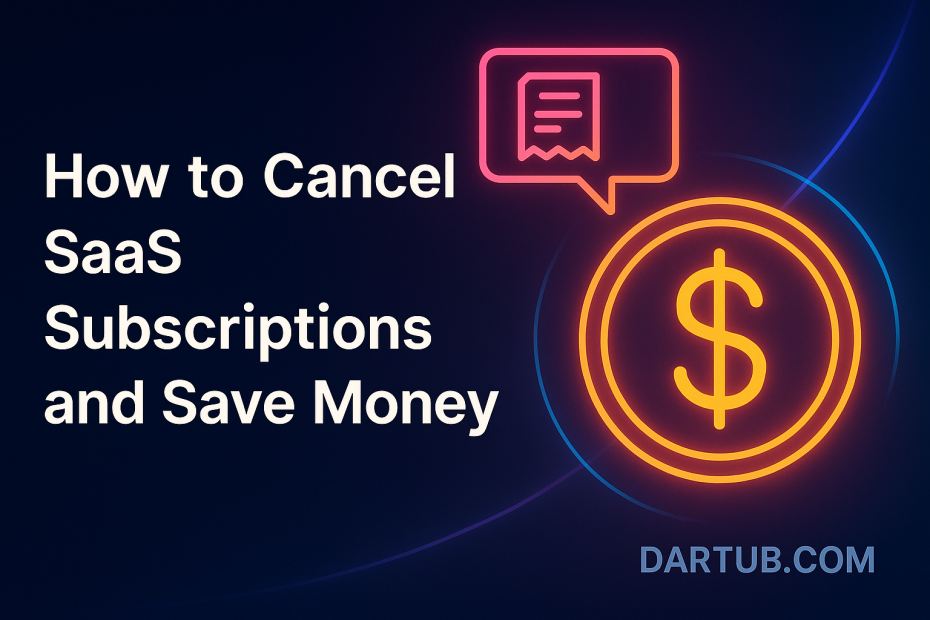SaaS (Software as a Service) has transformed how we use software—offering everything from productivity tools to marketing automation on flexible monthly plans. But as helpful as these subscriptions are, they can also silently drain your finances. In this guide, we’ll break down how to cancel SaaS subscriptions effectively, regain control over your budget, and start saving money without losing essential services.
Whether you’re a freelancer, small business owner, or digital consumer, this step-by-step guide is tailored for you.
Why SaaS Subscriptions Drain Your Wallet
While $10 to $50 per month might not seem like much, the costs add up—especially if you:
- Subscribe to multiple tools for similar functions
- Forget to cancel free trials
- Get charged annually without reminders
- Don’t track usage vs. value
Many people pay for services they don’t use—or forget they’re still subscribed to. It’s time to change that.
Step 1: Identify All Active Subscriptions
Before you cancel anything, you need a clear view of what you’re paying for.
🔍 Use These Tools to Track Subscriptions
- Truebill (Rocket Money) – Links to your bank account and identifies recurring charges
- Bobby – Manual tracking app with reminders
- Mint – Tracks all your financial accounts in one place
- Cleo – AI-powered financial assistant
Manual Audit (Old School, Still Works)
- Check your email inbox for receipts
- Review credit card and PayPal statements
- Look at mobile subscriptions through the App Store or Google Play
Step 2: Evaluate Usefulness and ROI
Once you have a list, ask yourself:
- Do I still use this service regularly?
- Can I replace this with a free or cheaper tool?
- Is there a consolidated platform that combines features?
Examples
- Replace Canva Pro and Adobe Express with one tool
- Ditch Trello if you’re actively using Notion
- Downgrade Grammarly if you’re not using premium features
Step 3: Cancel Unused or Unnecessary Subscriptions
Every platform has its own cancellation process, but here are general tips:
💡 How to Cancel SaaS Subscriptions
- Log in to the official website (avoid third-party sites)
- Go to account settings or billing
- Look for options like “Manage Subscription”, “Cancel Plan”, or “Turn Off Auto-Renewal”
- Confirm via email if required
Platform-Specific Notes
- Apple App Store: Settings > Apple ID > Subscriptions
- Google Play: Google Play > Payments & Subscriptions
- PayPal: Settings > Payments > Manage automatic payments
Step 4: Replace with Free or Lower-Cost Alternatives
If you need a similar tool but want to save:
Popular SaaS Alternatives
- Grammarly Premium → QuillBot or Hemingway App (free)
- Canva Pro → Adobe Express Free or VistaCreate
- Zapier → Pabbly Connect (cheaper) or Make (Integromat)
- Hootsuite → Buffer Free Plan
- Dropbox → Google Drive (free tier)
Step 5: Set Up Subscription Reminders and Reviews
Prevent future waste by setting reminders:
- Add calendar events for trial expirations
- Use subscription tracking apps like Truebill or Bobby
- Set a monthly review to evaluate active services
Bonus Tips: How to Negotiate Discounts Instead of Cancelling
Some platforms offer discounts when you attempt to cancel:
- Start the cancellation process and pause before confirming
- Look for prompts like “Wait! Here’s 30% off”
- Contact customer support and ask for a downgrade or discount
Example Script
“Hey there, I’m considering canceling due to budget concerns. Are there any promotions or lower-tier plans you could offer?”
How Much Can You Save?
Let’s say you cancel 4 unused subscriptions at $25/month each:
- That’s $100/month or $1,200/year back in your pocket.
For freelancers and startups, this can cover web hosting, ads, or even new hardware.
When You Shouldn’t Cancel
Sometimes canceling isn’t the smartest move:
- If it’s mission-critical software (e.g., invoicing or CRM)
- If it saves you significant time or manpower
- If canceling now loses grandfathered pricing
Final Thoughts
SaaS subscriptions can be game-changers—but only when managed wisely. Audit your stack regularly, cut the fluff, and shift your budget toward tools that truly move the needle.
Small cuts lead to big savings. And with tools and habits in place, you can keep more of your money while staying productive.
